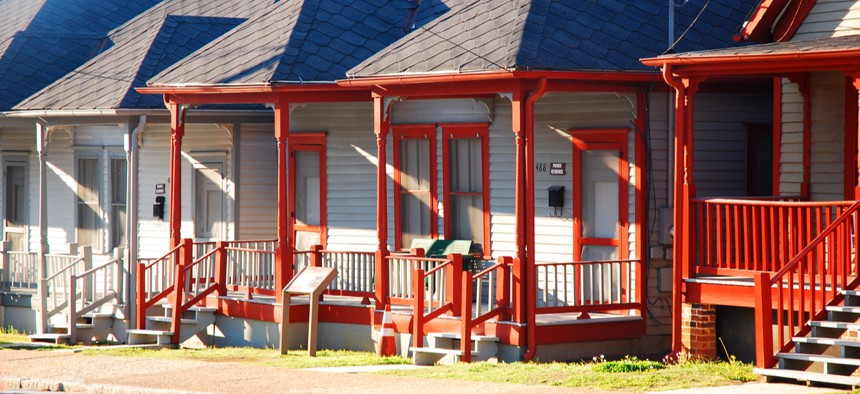Local Leaders Talk Solutions to Rising Costs of Living

Atlanta’s Sweet Auburn neighborhood is historically black but has been gentrifying in recent years. Mayor Keisha Lance Bottoms said maintaining “legacy residents” is a priority in neighborhoods with rising home prices. Shutterstock
At an event in Washington D.C., mayors and city council members spoke about the need for local solutions helping people cope with the increased costs of housing, child care and health care.
Over the last decade, unemployment plummeted and wages improved. But at the same time, almost every cost of living metric rose dramatically. Home prices and rent costs have soared. Child care is more expensive than college in 33 states. Health care bills are at the root of two-thirds of personal bankruptcies.
Families are clearly struggling with the monthly costs associated with living in America—and local leaders say that city governments are in a position to implement policies that can help.
At an event hosted in Washington, D.C. by The Washington Post on Wednesday, the mayors of Louisville, Kentucky and Atlanta, as well as a city councilmember from Philadelphia, spoke about local solutions to cost of living hikes.
In Philadelphia, Councilmember Kendra Brooks, a single mother of five and a member of the Working Families Party, is concerned with the cost of child care. She is currently sponsoring a bill that would mandate employers in the city provide 12 weeks of paid parental leave. The bill would trickle down from employers of 50 or more in the first year to 25 or more in the second year and 10 or more in the third year.
“We see that the hustle and bustle of life is preventing people from being good caretakers or even taking care of themselves,” Brookes said. “I’ve experienced these issues first hand, and we need people in politics who can speak to the people, not statistics, who are affected by these issues.”
Brooks said that the cost of child care while parents work is sucking up huge portions of people’s income in the city—the average cost for full-time day care for an infant is $10,920 per year, almost as much as the average cost of a one-bedroom apartment—and that allowing people to take paid time off to care for their children would be a financial boost for many families.
In Atlanta, Mayor Keisha Lance Bottoms is primarily concerned with housing. The cost of rent for a two-bedroom apartment has surged by 65% since 2009, making Atlanta the most expensive rental market in the South. Home prices rose by 98% in the same time frame, but household income hasn’t kept pace, increasing by only 13%. The city is facing an affordable housing shortage, but 90% of apartments built in the city in 2017 qualified as “luxury” units.
On Wednesday, Bottoms discussed her pledge to dedicate $1 billion to a plan to create and preserve 20,000 units of affordable housing in the city by 2026. “We’re working towards an Atlanta that’s equitable, that’s affordable, and that’s resilient,” she said. The city would achieve that, she said, by “combining commerce and compassion.”
Gentrification has run rampant through Georgia’s capital city, displacing thousands of black residents who have lived in Atlanta for generations. During her time on the city council, Bottoms passed legislation creating “displacement-free zones,” which give residents in areas sensitive to rising home prices—like those near the Mercedes-Benz Stadium where the Atlanta Falcons play—assistance in paying property tax increases. Bottoms said the goal is to retain “legacy residents.”
In Louisville, Kentucky, where the eviction rate is double the national average, Mayor Greg Fischer said he was also concerned with gentrification and displacement. “Our goal is to regenerate without displacement,” he said. “The more rapidly your city is growing, the more difficult that is … [but] there are systems we can put in place at the local level to stop gentrification.”
Fischer said that down payment assistance is a “radically effective” and “relatively inexpensive” way to help black families stay in place, as well as build wealth. Louisville’s system helps homebuyers with an income at or below 80% of the area median income to apply for assistance. “The question we’re asking is: Are we talking about the ability of our citizens to survive, or are we creating conditions where they can thrive?” Fischer said.
One of the main groups that Fischer said he wants to see thrive are those who cycle through the correctional system. Kentucky is one of only a handful of states where prison populations are rising instead of falling and nearly half of incarcerated people are housed in overcrowded local jails. Overcrowding makes it harder to care for Louisville residents who arrive needing drug addiction treatment and medical care. “The biggest mental health center in any city is the jail,” Fischer said. “The majority of things we deal with have to do with poverty.”
Fischer said Louisville is working to create services for people who are released from jail that include things like housing stipends to ensure people don’t end up homeless, a situation that could lead to their eventual return to jail.
In Atlanta, a task force will this month deliver recommendations to Bottoms about how to repurpose the city jail there—a 471,000 square foot facility, that, thanks to criminal justice reforms, now usually holds fewer than 100 people per night. The plan is to transform the facility into an equity center, offering job training, GED courses, housing assistance, and health care resources. “We want people to not think of incarceration as their first chance to access services,” Bottoms said.
Fischer said that efforts to transform institutions like the jail in Atlanta are sorely needed—and that local government leaders need to step up. “The systems that we’re talking about may have worked a decade ago, but they’re not working today,” he said.
Emma Coleman is the assistant editor for Route Fifty.
NEXT STORY: America is Aging and That Could Present Problems for Some States






